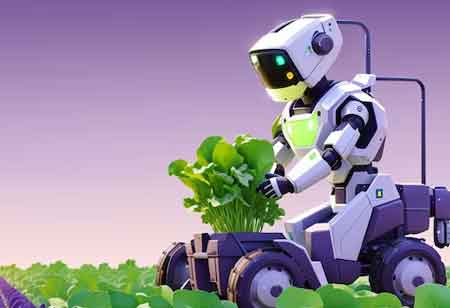Thank you for Subscribing to Agri Business Review Weekly Brief
Agricultural Robots: Transforming Modern Farming with AI and Machine Learning
Agricultural robots, powered by AI and machine learning, are revolutionizing farming by enhancing efficiency, precision, and sustainability.

By
Agri Business Review | Tuesday, March 11, 2025
Stay ahead of the industry with exclusive feature stories on the top companies, expert insights and the latest news delivered straight to your inbox. Subscribe today.
Fremont, CA: The agricultural robot market is increasing because it has diverse applications that change farming practices. These include inventory management in agriculture, weather monitoring, pruning, spraying, irrigation, dairy farming, field mapping, harvesting, and soil management. Spraying robots, automated harvesting systems, milking robots, drones, and driverless tractors are all types of agricultural robots which have played important roles in increasing efficiency, precision, and productivity in agriculture, thus solving the main problems in the industry and opening up a future for sustainable development and technological progress.
The Emergence of Agricultural Robots
Agricultural robots are revolutionizing traditional farming practices by focusing on labor shortages, climate change, and sustainable agriculture requirements. Robotics in farming is an excellent example of human ingenuity in pursuit of efficiency and innovation. As these machines develop, they are expected to transform the agricultural sector regarding productivity and sustainability.
Types of Agricultural Robots
From planting to harvesting, tasks that were once performed with human hands are now completed by various robots. Independent tractors and drones for field management allow farmers to cover large areas in very little time. Such machines can plant seeds, give fertilizers, and assess crop health with great precision. Harvesting robots take fruits and vegetables gently so as not to damage them. On the other hand, weeding and planting robots allow crops to receive all their necessary nutrients. Monitoring and maintenance robots use advanced sensors and AI to track plant health, soil conditions, and pest activity, providing real-time data for informed decisions.
Benefits of Agricultural Robots
The deployment of robots in agriculture offers many advantages, such as increased productivity and efficiency. Robots can work around the clock, unaffected by fatigue or adverse weather, leading to higher yields. Their accuracy in planting and spraying activities ensures proper resource use, thus eliminating waste and increasing crop quality. Robots also save on labor costs and seasonal workers, which is helpful in areas where labor is scarce due to chronic shortages. Robots also improve sustainability by reducing the application of chemicals and the footprint of farming.
Challenges and Limitations
Although agricultural robots are promising, they have limitations that must be overcome to make them widespread. High acquisition and investment costs in purchasing and maintaining them are expensive, particularly for small-scale farmers. The technicalities and need for frequent maintenance make them less practical. They need to be durable and robust enough to function effectively under harsh agricultural conditions. Implementing robots in current farming systems can be challenging and demanding in terms of change. Other factors include ethical considerations and the impact on the labor market, such as replacing human workers and requiring new skill sets.
Future of Agricultural Robots
The future of agricultural robots is bright, given that AI and machine learning will make robots more intelligent and capable. These technologies will enable robots to execute complex tasks, adapt to changes in conditions, and make autonomous decisions based on real-time data. This potential impact on global food production is immense because yields can be increased, waste can be reduced, and farming efficiency can be improved. Agricultural robotics will witness massive developments within the next decade regarding the increased penetration and integration into farming activities worldwide. Such development will further enhance productivity and contribute to the sustainability and resilience of the sector.





